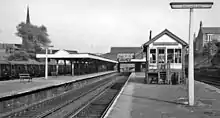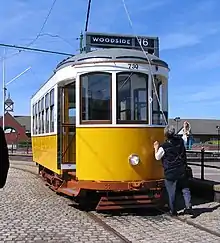Birkenhead Park railway station
Birkenhead Park railway station is a station serving the town of Birkenhead, in Merseyside, England. It lies on the Wirral Line of the Merseyrail network.
Birkenhead Park | |
|---|---|
 | |
| General information | |
| Location | Birkenhead, Wirral England |
| Coordinates | 53.3974°N 3.0390°W |
| Grid reference | SJ310894 |
| Managed by | Merseyrail |
| Transit authority | Merseytravel |
| Platforms | 2 |
| Other information | |
| Station code | BKP |
| Fare zone | B1 |
| Classification | DfT category E |
| Key dates | |
| 1888 | Opened |
| 1938 | Electrified |
| Passengers | |
| 2017/18 | |
| 2018/19 | |
| 2019/20 | |
| 2020/21 | |
| 2021/22 | |
| Notes | |
Passenger statistics from the Office of Rail and Road | |

History
The name of the station comes from nearby Birkenhead Park, one of the UK's first Victorian municipal parks. In 1850 its layout - created by Joseph Paxton - had a profound influence on visiting American landscape architect Frederick Law Olmsted. Eight years later he took inspiration from Birkenhead Park (and other green spaces like Derby Arboretum) to win a competition to design New York's new city park.
The station was opened on 2 January 1888, as a joint interchange station between the Seacombe, Hoylake and Deeside Railway and the Mersey Railway.[1] The station replaced the Wirral Railway's original terminus at Wallasey Bridge Road, which was close to the present-day Birkenhead North station. The station was an interchange between the Wirral Railway's line to West Kirby and the Mersey Railway's new line to Liverpool Central low level station. On the same day of opening, the Wirral Railway's new line to Wallasey Grove Road opened, which was extended to New Brighton later the same year.
The station was built at the western portal of the Mersey Railway tunnel that ran into central Birkenhead and Liverpool's city centre. From its opening the station had two island platforms to facilitate across-platform transfer between the Mersey Railway and the Wirral Railway.[2] The northern pair of tracks were used exclusively by Mersey Railway trains. The centre and southern pairs of tracks were available to the Wirral Railway.[2]
Mersey Railway electrification
.jpg.webp)
On 3 May 1903, the Mersey Railway to Liverpool was changed over from steam to electric trains, with a 650 V DC fourth rail system[3] and Mersey Railway electric units built by Westinghouse.
There was a small Mersey Railway electric car shed at the eastern end of the station, on the northern side of the line, which held two 6-car trains.[2] This was built on level ground, with the tracks towards the tunnel to Liverpool dropping steeply alongside. The car shed was removed in the 1970s.
Fatal accident
On 6 December 1922 an accident occurred at the station, at around 4pm, between two trains of the Wirral Railway. The train heading to West Kirby, which was late, was leaving the station and collided with a train from West Kirby. There was one fatality and eight other passengers sustained serious injuries, with a further 36 people suffering from shock.[4] This was the first fatal passenger accident to occur on the Wirral Railway.[5]
LMS electrification
.jpg.webp)
Between 1936 and 1938, The London, Midland and Scottish Railway electrified the lines from Birkenhead Park to West Kirby and New Brighton using a 650 V DC third rail to match the system of the Mersey Railway. The smoke free electric trains facilitated through operation to underground sections of Birkenhead and Liverpool, with the line terminating at Liverpool Central low level station.[6] The LMS electric trains were brought into passenger service on 14 March 1938.[7] The need to change at Birkenhead Park was removed transforming the station into a through station. It was normal for the new LMS trains to operate the Liverpool to West Kirby route, and the older Mersey Railway trains to operate the Liverpool to New Brighton route, except for Sundays and bank holidays.[8][9]
From 1938 electrification of the Wirral lines integrated both the Mersey Railway and LMS (Wirral) railway services to New Brighton and West Kirby. However the former Wirral Railway branch to Seacombe was still operated by steam trains, not those of its owner the LMS but trains of the LNER from the Chester and Wrexham lines through Bidston. The additional facilities beyond a simple two-track through station became redundant at Birkenhead Park. Despite which, the layout retained all four platforms, two in each direction, until the 1970s. A new 60-lever signal box was opened in 1938, which was reduced to 25 levers in 1972 and which closed on 28 February 1988.[10]
World War II bombing
The station building is not the original. The first station building was destroyed when two aerial bombs were dropped by German aircraft on the night of 12–13 March 1941, during the Second World War. After the bombing, through services were restored after five days with the station reopened to passengers after eleven days.[11]
Postwar

The outer platform faces were hardly used, apart from a handful of trains which were stored outside of peak hours in the sidings which remained at all four corners of the station,[5] and outside the island platforms. In the 1970s, there were a number of rationalisations to the layout. At one stage, through trains used the outer tracks of the station, while a bay platform was fashioned between these to allow a proposed Liverpool-to-Birkenhead Park extra peak-hour shuttle service, which in the event was never started. The layout was then simplified again to the current one, retaining the former southern island platform with just a through road either side,[12] with the former northern platform demolished in 1992.[5][13]
Facilities
The station is staffed, during all opening hours, and has platform CCTV.[14] The island platform has a waiting shelter. There is a payphone, booking office and live departure and arrival screens, for passenger information. A 16-capacity lift was opened in August 2022, allowing step-free access for all passengers.[15] [16] The station has no car park but there is secure cycle storage for 32 bikes.[17]
Services
Trains operate every 15 minutes (Monday to Saturday daytime) to New Brighton and West Kirby and every 5–10 minutes via Hamilton Square and the Mersey Railway Tunnel to Liverpool. At other times, trains run every 30 minutes to New Brighton and West Kirby, and every 15 minutes to Liverpool.[18] These services are all provided by Merseyrail's fleet of Class 507 and Class 508 EMUs.
Gallery
 Birkenhead Park station booking office as seen from the platform.
Birkenhead Park station booking office as seen from the platform..jpg.webp) The platform waiting rooms.
The platform waiting rooms. Sculptures on the platform.
Sculptures on the platform.
References
- Maund 2009, p. 27.
- Maund 2009, pp. 102–103.
- Gahan 1983, p. 32.
- Maund 2009, p. 217.
- Merseyside Railway History Group 1994, p. 32.
- Maund 2009, p. 156.
- Maund 2009, p. 166.
- Gahan 1983, p. 50.
- Maund 2009, p. 154.
- Mitchell & Smith 2014, fig. 12.
- Maund 2009, pp. 177–178.
- Maund 2009, p. 215.
- Mitchell & Smith 2014, fig. 14.
- "Station Facilities for Birkenhead Park". National Rail. Retrieved 18 December 2013.
- "New lift at rail station making a difference to passengers". Wirral Globe. Retrieved 28 August 2022.
- "Birkenhead-park train station | timetable | ticket prices & facilities". www.merseyrail.org. Retrieved 8 April 2019.
- "Birkenhead-park train station | timetable | ticket prices & facilities". www.merseyrail.org. Retrieved 6 February 2017.
- "Wirral Line timetable" (PDF). Merseyrail. Archived from the original (PDF) on 19 December 2013. Retrieved 18 December 2013.
Sources
- Gahan, John W. (1983). The Line Beneath the Liners: A hundred years of Mersey Railway sights and sounds. Birkenhead: Countryvise Ltd. ISBN 978-0-907-76840-1.
- Maund, T.B. (2009). The Wirral Railway and its Predecessors. Gloucestershire: Lightmoor Press. ISBN 978-1-899-88938-9.
- Merseyside Railway History Group (1994). Railway Stations Of Wirral. Ian & Marilyn Boumphrey. ISBN 1-899241-02-7.
- Mitchell, Vic; Smith, Keith (2014). Birkenhead to West Kirby. West Sussex: Middleton Press. ISBN 9781908174611. OCLC 885451764.
External links
- Train times and station information for Birkenhead Park railway station from National Rail
- Station information for Birkenhead Park railway station from Merseyrail
| Preceding station | Following station | |||
|---|---|---|---|---|
| Birkenhead North towards New Brighton or West Kirby |
Merseyrail Wirral Line |
Conway Park towards Liverpool Central | ||
